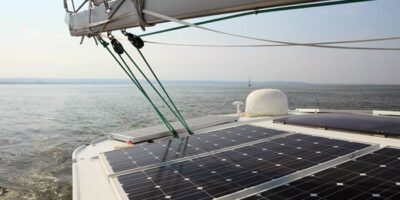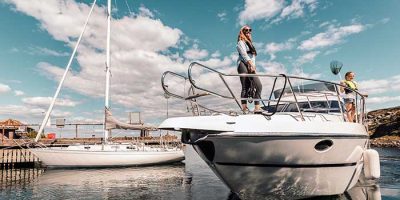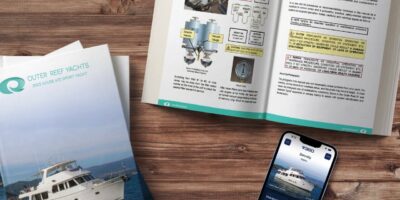Hurricane Preparation Saves
These boat owners aggressively prepped their boat for survival at the dock using proven techniques as powerful Hurricane Florence zeroed in.
- January 16, 2024
Case Study: The Trial Of Her Life
August through October is prime hurricane season in the Carolinas. Everyone who owns a boat here is aware of the risk. Our marina is on the Neuse River about 20 miles from where it empties into Pamlico Sound, a large body of water between the mainland and famous Outer Banks of North Carolina. We have 360 degrees of protection; docks are fixed (nonfloating), were rebuilt about five years ago, and are in good shape. The pilings are 9 feet above the normal high tide. The marina doesn’t require evacuation because it’s essentially a hurricane hole.
During a tropical storm, we know that boats are usually safer ashore, but haulout for an event like 2018’s Hurricane Florence is not an option for everyone. Sometimes boats have to be moved a great distance to get to a haulout facility, and sometimes you simply can’t get hauled out if you didn’t pay a nonrefundable deposit up front the previous spring to get on a hurricane haulout list (we did not). Even so, I felt most of the nearby marinas where we’d normally take our boat to haul out were not well protected. Turns out, I was right.
Every June, my wife Gayle and I discuss our plan for the upcoming hurricane season. This year we planned to keep Far Reach, our highly modified Cape Dory 36, which I’d spent six years rebuilding, in the marina. We aimed to enjoy our boat close to home during September and October, partly so we could be present and prepare if a hurricane threatened our area. Before the hurricane season began, we made one of the most important decisions we could have made – we chose to put Far Reach in one of two empty 26-foot-wide catamaran slips. While others saw the wide slip and contrary current as inconvenient, I saw it as room for Far Reach to survive should our luck avoiding hurricanes run out.
How To Survive A Hurricane In A Marina
- Develop a comprehensive storm-action plan and be ready to implement it. Your marina should have a written, posted, storm-action plan available to every boat owner. (Our marina didn’t have one.) It should be on the marina’s website and emailed to all boat owners. The marina should be proactive and open an email dialogue with boat owners as soon as a storm looks like a threat.
- A proactive dockmaster is critical. Again, we didn’t have one. A system must be in place for them to alert owners and management if boats aren’t prepared so preemptive action can be taken. The dockmaster ideally should have a bosun’s locker with extra ropes, chafe guards, sail ties, and so on, to secure unprepared boats.
- Docklines should be of the right size, doubled, with chafe protection. Your boat must have good thru-bolted backing plates for the cleats, preferably well tied in to deck structure. Lines should have enough slack for the forecasted surge. Ensure they can be adjusted from the dock if there’s any chance you or someone else can safely visit the boat. Cleat them properly, and half hitch them if they’re going to be underwater so they don’t untie.
- Reduce windage. Remove the dodger, bimini, solar panels, wind generator, kayaks, cooking grills, and all sails, especially furling headsails.
- Use the best slips available, even if you have to move.
- Analyze how the wind and surge will affect your marina. Position your boat accordingly.
- Use new high-quality nylon dock lines and chafe protection.
- Reach out to adjacent boat owners. Share contact info and formulate plans together. They may not know what to do and be too embarrassed to ask, or they may be out of town.
- Access your boat if safe to do so. Adjusting lines before and after a storm can be the difference between no damage and a lot of damage. But remember, your life is more important than your boat. No unnecessary risks!
Creating An Action Plan
September 9, 2018
We’d begun to read about Hurricane Florence, and now there were early projections for landfall on the southeast coast of the U.S. We set our plan in motion. First, we turned Far Reach around in her slip so her bow faced out toward the northeast, from where we expected the strongest wind to come, and which presented the longest fetch in the marina. We removed all canvas, spinnaker pole, hard dinghy, dinghy sailing rig, pram hood, outboard engine, and solar panel to reduce windage. We removed as much gear on board as possible, even the cushions. By the time we finished, Far Reach was practically empty.
September 10, 2018
The forecast became dire. The exact point of landfall was unknown,to be accurate: 9 to 13 feet, with 30 inches of rain.
September 11, 2018
We expected the roads would become blocked by downed trees, so we made a reservation at the hotel on the Marine Corps base where our marina was located. I spent six years and 6,000 hours rebuilding Far Reach from a bare hull and, other than my family, it’s the love of my life. She was insured, but the amount was barely enough for the material I had into her. Our house, on the other hand, was insured for its full value, and my sister, a retired fire captain, agreed to stay there. By staying in that nearby hotel, we could eliminate blocked roads as obstacles to getting to the boat to check lines during the surge and address any concerns until the last possible moment. After the hurricane passed and the surge dropped, we wanted to be able to take in the slack in the dock lines so the boat would be protected from hitting the dock.
Painstaking Preparation
September 12, 2018
Like any boater, I’m loathe to cut up a line, but we had to have as strong a dockline system as possible. So we cut a 250-foot-long ¾-inch double-braid nylon anchor line into four lines of about 50 feet, and two of 25 feet. We had a half-dozen old-style rubber Taylor Made Chafe Guards and another half dozen Chafe-Pro line protectors. The dockline plan proved crucial. The fixed docks are normally about 4 to 5 feet above the water. But with a 9- to 13-foot surge forecasted, we could have anywhere from 5 to 9 feet of water over the top of the dock. Docklines had to accommodate our boat rising the same amount of height.
This is where the wide slip was of such great value. We centered Far Reach in the slip and created as much slack as we could in the lines – not so much that she could make contact with either side, yet enough slack that she could float up without breaking the lines. The forward spring lines were the linchpin for the rest of the lines because winds were expected from the bow and would push her back toward the dock behind her. As the water rose, she’d be pulled forward as the relative length of the line shortened. Aft spring lines would keep her centered fore and aft. We also added bow and stern lines but not breast lines, as they wouldn’t, by their geometry, be long enough to accommodate the surge.
“We centered Far Reach in the slip and created as much slack as we could in the lines.” – John Stone
Our everyday docklines for the 16,000-pound Far Reach are high-quality New England Ropes ½-inch three-strand nylon, essential for their stretch, which reduces dynamic shock loading on the boat’s cleats. Also, you can inspect three-strand lines; there’s nothing hidden under an outer cover as with double-braided. As an added precaution, we doubled all docklines for added strength and to provide redundancy should a line break or chafe through. To our normal eight bow, stern, and spring lines, we added eight more for a total of 16 dock lines, all long enough to accommodate the surge expected in the marina. Then, we added chafe protection to the lines.
We also developed a cleating plan. We wouldn’t be able to get on the boat to adjust the lines once the surge began, so we decided to terminate the lines on the boat and make them adjustable on the dock. We also avoided putting too many lines on the horns of the boat’s cleats and decided to limit it to one line through the center hole and over the top of the cleat and the other secured to the cleats in the traditional manner. I tied off the tails with half hitches to assure they wouldn’t come lose in the high wind.
The dock has fixed pilings on each outboard end where we secured the bow lines and aft spring lines. Pilings are great because, unlike cleats, they likely won’t tear out. Another advantage is that you can position the lines high on the pilings, which allows more room for the lines to accommodate the surge. We secured all the lines to the pilings with rolling hitches, then took the tails around the piling one more time and tied the ends off to the standing part with half hitches.
This is where long lines can really be of great value. The stern lines and forward springs had to be terminated on cleats on the dock as that was all that was available. We secured them in the normal manner, but tied all the tails off with half hitches because as the surge rose above the dock, the cleated lines would be underwater, and we were concerned the tails could come loose in fast-moving current. There was nothing more to be done, so we loaded up our truck with a cooler, ice, food, water, flashlights, rain gear, life jackets, coils of lines, tools, and handheld VHF radio, and moved into our hotel.
Never Stay Aboard In A Hurricane
One of the most dangerous mistakes a skipper can make is to stay aboard his or her boat during a hurricane. Several accounts given in our BoatUS Marine Insurance claims files indicate that there is little, if anything, a skipper can do to save a boat when winds are blowing over 100 mph, tides are surging, and visibility is only a few feet.
What can happen? Consider the case of a 68-year-old skipper in Charleston, South Carolina, who together with his grown nephew, took his trawler up the Wando River to ride out Hurricane Hugo in what they thought would be a “sheltered” hurricane hole. He reported that the boat seemed to be doing fairly well initially, but later that night the wind picked up to over 100 mph and 15-foot seas sent the boat crashing completely over.
The two men were trapped briefly in a pocket of air underwater when another wave rolled the boat upright. They then scrambled onto the deck and were eventually rescued, but not before almost drowning and being overcome by exposure.
Another skipper who stayed aboard his motorsailer at a marina during Hurricane Gloria had to jump overboard and swim through breaking waves, drifting boats, and debris after another boat broke free and rammed its mast (the boat was on its beam ends) through his boat’s pilothouse window. He was lucky to reach shore alive.
Two Miami men who stayed aboard a sportfisherman (not insured by BoatUS) during Hurricane Andrew were not so lucky. They both drowned while trying to escape their battered and sinking boat. When a hurricane is approaching, secure extra lines, set out anchors, add chafe protection, strip the boat above and belowdecks, and so on. Do whatever it takes. Then head inland. Your boat can be replaced. You can’t.
Hurricane Florence Hits, And It's A Big One
September 13, 2018
By 11 a.m., water was just over the dock, and all marina power had been shut off. This is important because energized shore power can be deadly to anyone on the docks when the rising water nears the shore-power pedestals. By 2 p.m., the water was about 18 inches over the dock. I added slack to the lines. We left for a few hours and returned at 6 p.m., hoping to have one last chance to adjust the lines. There was 4 feet of water over the dock and the wind was strong. It was no longer safe to venture out onto the dock to check the boat. All we could do was say a prayer for Far Reach and return to the hotel. It was a long night knowing the boat I’d spent years building, and which had safely carried me to and from the West Indies, was having the trial of her life.
September 14, 2018
By 10:30 a.m. I felt it was safe to go to the marina. The first thing we saw through the wind-whipped tree limbs was complete destruction — at least four boats sunk, all more than 34 feet. Five had been driven up on land; one was missing entirely. Suddenly I saw Far Reach‘s mast through the wind-driven rain. She was afloat! We made our way to the parking lot, still under a foot of water. I donned my life jacket and very cautiously worked my way out along the dock. Before the storm, we’d rigged a hand line between the pilings for this possible situation. There can be many dangers wading in receding floodwaters, including displaced snakes.
The destruction was shocking. Every boat on B Dock was damaged. An Islander 37 a slip away from Far Reach was sunk. But our hard work had paid off; Far Reach was undamaged. We estimate the marina had 10 to 12 feet of surge and winds of 80 knots. With the surge rapidly falling, I reduced line slack to ensure the boat wouldn’t contact the dock.
Looking back, we didn’t learn anything that hasn’t been written about before. We were lucky, yes, but also aggressively followed proven techniques, and credit those for Far Reach surviving without damage. This was a large, powerful hurricane with enormous long-duration surge. With forethought, an understanding of how the storm will affect your marina, advance planning, hard work, active marina staff, and a little luck, your boat could survive one, too.
Article By John Stone, Edited By Charles Fort
Contributor, BoatUS Magazine
About Vessel Vanguard
Vessel Vanguard is a leading marine safety and maintenance management software provider dedicated to revolutionizing the maritime industry. With a commitment to innovation and excellence, Vessel Vanguard delivers cutting-edge solutions to streamline operations and enhance vessel performance and safety.
Latest Industry Insights

Embracing E-Boating Efficiencies

Boat Fuel Systems

The Future of Boats & Boating

Yacht Navigation Light Inspection
View All of Our Industry Insights
Navigate maritime with the latest news, practical how-to guides, insightful analyses and more.
